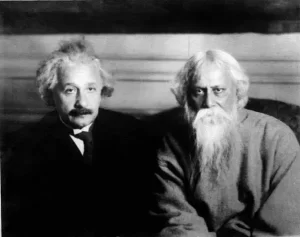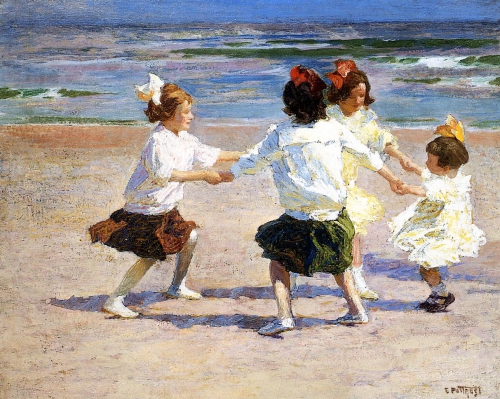 In 1913, the Nobel Prize in Literature was awarded to the Bengali poet Rabindranath Tagore “because of his profoundly sensitive, fresh and beautiful verse, by which, with consummate skill, he has made his poetic thought, expressed in his own English words, a part of the literature of the West”
In 1913, the Nobel Prize in Literature was awarded to the Bengali poet Rabindranath Tagore “because of his profoundly sensitive, fresh and beautiful verse, by which, with consummate skill, he has made his poetic thought, expressed in his own English words, a part of the literature of the West”
1921 the Nobel Prize in Physics was awarded to the German Albert Einstein “for his services to Theoretical Physics, and especially for his discovery of the law of the photoelectric effect”.
On July 14, 1930, the two met at Einstein’s house at Kaputh, near Postdam, Germany, and their conversation about nature, beauty, and reality was recorded They had a second conversation, at the Dr. Mendel House where they talked about family, youth movement of Germany, youth movements, chance and predetermination, and music.
But before all that here is Tagore’s quite lovely Gitanjali (Song Offerings) Verse #60 written in the year before the prize.
On the Seashore of Endless Worlds
by Rabindranath Tagore
On the seashore of endless worlds children meet.
The infinite sky is motionless overhead
and the restless water is boisterous.
On the seashore of endless worlds the children meet with shouts and dances.
They build their houses with sand and they play with empty shells.
With withered leaves they weave their boats
and smilingly float them on the vast deep.
Children have their play on the seashore of worlds.
They know not how to swim, they know not how to cast nets.
Pearl fishers dive for pearls, merchants sail in their ships,
while children gather pebbles and scatter them again.
They seek not for hidden treasures, they know not how to cast nets.
The sea surges up with laughter, and pale gleams the smile of the sea-beach.
Death-dealing waves sing meaningless ballads to the children,
even like a mother while rocking her baby’s cradle.
The sea play with children, and pale gleams the smile of the sea-beach.
On the seashore of endless worlds children meet.
Tempest roams in the pathless sky, ships get wrecked in the trackless water,
death is abroad and children play.
On the seashore of endless worlds is the great meeting of children.

While children search for shells and build sandcastles, the adults go to work and to war.

On the Nature of Reality: Einstein and Tagore in Conversation not on the Beach
The conversation between Tagore and Einstein centers around their differing perspectives on the nature of truth, beauty, and the relationship between humanity and the universe. The discussion was published in the January, 1931 issue of Modern Review.
TAGORE: You have been busy, hunting down with mathematics, the two ancient entities, time and space, while I have been lecturing in this country on the eternal world of man, the universe of reality.
EINSTEIN: Do you believe in the divine isolated from the world?
TAGORE: Not isolated. The infinite personality of man comprehends the universe. There cannot be anything that cannot
be subsumed by the human personality, and this proves that the truth of the universe is human truth.
EINSTEIN: There are two different conceptions about the nature of the universe — the world as a unity dependent on humanity, and the world as reality independent of the human factor.
TAGORE: When our universe is in harmony with man, the eternal, we know it as truth, we feel it as beauty.
EINSTEIN: This is a purely human conception of the universe.
TAGORE: The world is a human world — the scientific view of it is also that of the scientific man. Therefore, the world apart from us does not exist; it is a relative world, depending for its reality upon our consciousness. There is some standard of reason and enjoyment which gives it truth, the standard of the eternal man whose experiences are made possible through our experiences.
EINSTEIN: This is a realization of the human entity.
TAGORE: Yes, one eternal entity. We have to realize it through our emotions and activities. We realize the supreme man, who has no individual limitations, through our limitations. Science is concerned with that which is not confined to individuals; it is the impersonal human world of truths. Religion realizes these truths and links them up with our deeper needs. Our individual consciousness of truth gains universal significance. Religion applies values to truth, and we know truth as good through own harmony with it.
EINSTEIN: Truth, then, or beauty, is not independent of man?
TAGORE: No, I do not say so.
EINSTEIN: If there were no human beings any more, the Apollo Belvedere no longer would be beautiful?
TAGORE: No!
EINSTEIN: I agree with this conception of beauty, but not with regard to truth.
TAGORE: Why not? Truth is realized through men.
EINSTEIN: I cannot prove my conception is right, but that is my religion.
TAGORE: Beauty is in the ideal of perfect harmony, which is in the universal being; truth is the perfect comprehension of the universal mind. We individuals approach it through our 2 own mistakes and blunders, through our accumulated experience, through our illumined consciousness. How otherwise can we know truth?
EINSTEIN: I cannot prove, but I believe in the Pythagorean argument, that the truth is independent of human beings. It is the problem of the logic of continuity.
TAGORE : Truth, which is one with the universal being, must be essentially human; otherwise, whatever we individuals realize as true, never can be called truth. At least, the truth which is described as scientific and which only can be reached through the process of logic—in other words, by an organ of thought which is human. According to the Indian philosophy there is Brahman, the absolute truth, which cannot be conceived by the isolation of the individual mind or described by words, but can be realized only by merging the individual in its infinity. But such a truth cannot belong to science. The nature of truth which we are discussing is an appearance; that is to say, what appears to be true to the human mind, and therefore is human, and may be called maya, or illusion.
EINSTEIN: It is no illusion of the individual, but of the species.
TAGORE: The species also belongs to a unity, to humanity. Therefore the entire human mind realizes truth; the Indian and the European mind meet in a common realization.
EINSTEIN: The word species is used in German for all human beings; as a matter of fact, even the apes and the frogs would belong to it. The problem is whether truth is independent of our consciousness.
TAGORE: What we call truth lies in the rational harmony between the subjective and objective aspects of reality, both of which belong to the superpersonal man.
EINSTEIN: We do things with our mind, even in our everyday life, for which we are not responsible. The mind acknowledges realities outside of it, independent of it. For instance, nobody may be in this house, yet that table remains where it is.
TAGORE: Yes, it remains outside the individual mind, but not the universal mind. The table is that which is perceptible by some kind of consciousness we possess.
EINSTEIN: If nobody were in the house the table would exist all the same, but this is already illegitimate from your point of view, because we cannot explain what it means, that the table is there, independently of us. Our natural point of view in regard to the existence of truth apart from humanity cannot be explained or proved, but it is a belief which nobody can lack—not even primitive beings. We attribute to truth a superhuman objectivity. It is indispensable for us—this reality which is independent of our existence and our experience and our mind—though we cannot say what it means.
TAGORE: In any case, if there be any truth absolutely unrelated to humanity, then for us it is absolutely non-existing.
EINSTEIN: Then I am more religious than you are!
TAGORE: My religion is in the reconciliation of the superpersonal man, the universal spirit, in my own individual being.
“On the Seashore of Endless Worlds” 1914 is the fifth song in John Alden Carpenter’s song cycle Gitanjali: Song Offerings based on the poetry of Rabindranath Tagore. Here it is sung by Thomas Hampson.
The featured image is a linocut “August: by Gail Brodholt.



Exquisite poem. I was unfamiliar with this piece of his and am grateful that you posted it.
Josie, Sue Scheid was amused that you both had posts on Einstein this week and recommended yours to her readers. For that I thank her and you! A book on the correspondence between these two had been on my book list for a while, and there now is a Kindle version on them talking, but you’ve supplied what long had me curious. Tagore conversing with Einstein was a lot more interesting, apparently, than Joyce’s meeting with Proust, and I’d assume Picasso’s with Paul Klee, though the idea of any two giants sharing views is seductive. The poem is quite beautiful.
P.S. Tagore is given credit for one of my favorite quotes. Beautiful, whether it’s believed or not:
Nirvana is not the blowing out of the candle. It is the extinguishing of the flame because day is come.
Crikey that is something. Thank you for that.
Thanks Curt. I love this idea of “great conversations”. The idea of informed minds in conversation is such a welcome change from what usually is called “debate”. I.e. people who disagree being forced into gladiatorial combat to lift ratings. Sometimes even – gasp – they can have different insights and perspectives rather than opposing views. I’m thinking now of Richard Dawkins and Helen Joyce.
Light v, Light.
What fun it would be to imagine conversations between great minds that never took place in real-time. We know enough to imagine Blake and Newton. Light and Heat. But think of all the other pairings of minds that it would be fun to imagine and drop in on. Who comes to your mind?
From my perspective in visual art, Agnes Martin and Ad Reinhardt. Both are considered in the Minimalist ambit by many, both were whip-smart and very articulate about what’s hard to translate into words, both still have books in print on their thoughts. And of course I admire their work. (Now I’ll probably ponder other contenders the rest of the day!)
Possibly my favorite post of yours!
Loved the poem Seashore – I had never read it. Excellent.
Plus the conversation fascinating. Thanks!
Sheila R Morris´s last blog post ..in case you missed it
Thanks Sheila.
This is so beautiful Josie. It captures the child’s joy in the moment and their unawareness of the cruelty of life. Very moving.
I thought so too.
That will have been quite a meeting.
That dialogue was fantastic. What genius
The dialogue of two geniuses who see the world totally different. i learned a lot from it. Thanks for sending. CAC